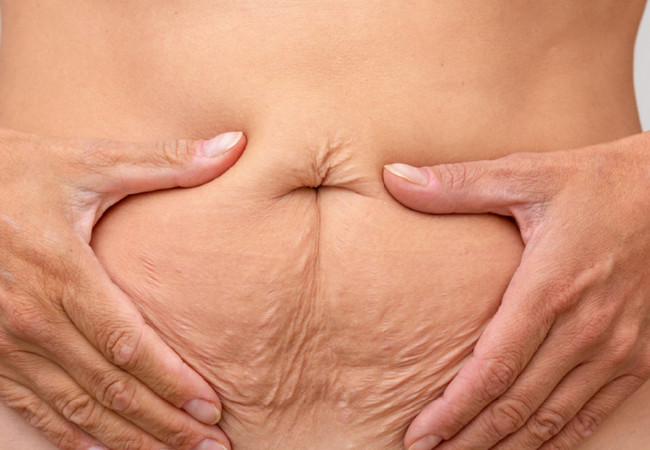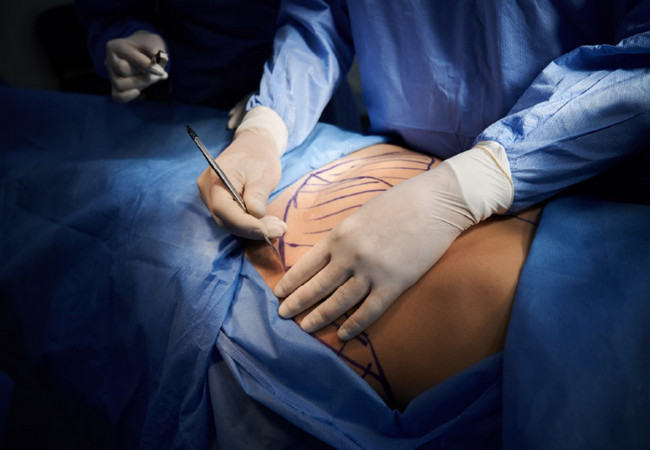Abdominoplasty
Information on abdominoplasty
One of the most common figure problems is the development of a "belly". People of normal weight can also develop a belly, as it is not necessarily due to increased fat storage in the lower abdominal area, but often just a decrease in the elasticity of the abdominal wall that causes the belly to bulge.
On the one hand, this is a typical consequence of getting older, but it can be exacerbated by pregnancy, operations, etc. In more pronounced cases - especially after massive weight loss - the skin can overhang and produce a so-called "fat apron".
A surgical tightening of the abdominal wall with removal of the overstretched, excess skin, but also the reunification and strengthening of the abdominal muscles can often be useful and help to achieve clear satisfaction with one's own figure and a new attitude to life.
In the hands of an experienced surgeon, this is a very efficient technique in which the patient should first have his or her weight, which he or she intends to maintain in the long term. A thorough analysis of the patient's anatomy is crucial to ensure that the problem is treated correctly.
Abdominoplasty - the most important facts in brief
- Technical term: abdominoplasty, tummy tuck, abdominal wall surgery, tummy tuck, rectus diastasis repair
- Type of anesthesia (anesthesia): General anesthesia
- Operation duration: 1.5 to 3 hours
- Hospital stay: outpatient or 1 overnight stay (depending on the extent of the operation)
- Socially acceptable: after approx. 1 week
- Able to work: after approx. 2-3 weeks (depending on professional activity)
- Costs: from CHF 6,000 to CHF 14,000 (depending on scope)
Further details on abdominoplasty
The basic principle of the operation is that the skin, which is no longer sufficiently elastic, is lifted via an incision in the bikini area and detached from the underlying muscles from the pubic area up to the ribcage.
If there is a gap in the straight abdominal muscles (rectus diastasis), this gap in the muscles can be closed again as part of the same procedure. The oblique abdominal muscles can also be medialized. This creates a clear waist accentuation again. The excess skin of the abdominal wall is then removed and the wound deep in the pubic area is closed again with multi-layered sutures.
If the extent of the procedure is small (often requested after pregnancies - "mommy makeover"), it is not necessary to move the navel: in this case it may be sufficient to make only one incision in the pubic area (mini-abdominoplasty).
Even if the problem is only localized due to a bulging, enlarged mons veneris (upper vulva) with possible skin retraction after a caesarean section or other procedures, the scope of the procedure is limited. A reduction in size by means of liposuction without removing skin and lifting the retracted scar may be a solution.
In the case of extensive excess skin, especially in the upper abdominal region, liposuction in the upper abdominal and waist region should be combined with the procedure, but it is also essential to move the navel, as pulling the skin down towards the pubic area alone would not allow the navel to retain its natural position. The navel is re-established in its original, "usual" position at the end of the operation. In addition, the abdominal wall can be strengthened and stabilized and the waist can be reshaped and accentuated by reuniting the vertical abdominal muscles that stand apart.
During the preliminary consultation, we will take plenty of time to clarify whether an abdominoplasty is a sensible measure for you, provide you with precise information and explain all open questions in detail. We will also realistically explain the risks and expected chances of success. Of course, we want to achieve an optimal result for you, with which you will be happy and satisfied in the long term.
On the day of the operation, the exact incision is marked again and after transfer to the operating room and induction of anesthesia, the excess skin and subcutaneous tissue is gently and successively removed; if necessary, the divergent muscles are reunited. If there is only a small excess of skin just below the navel, a so-called mini-abdominoplasty can be performed, in which the navel does not have to be moved. This can be performed on an outpatient basis.
The patient must wear a compression girdle for three to six weeks and also take considerable physical rest in order to support rapid reattachment of the skin to the muscles. The wound is then closely monitored and cared for on an outpatient basis in our practice.
A tummy tuck is a more extensive procedure that creates a larger wound area. This entails a certain risk of thrombosis. Rare complications such as secondary bleeding, fluid accumulation under the skin (seroma) or infections can also occur. We do everything medically possible to avoid this for you and follow you closely after the procedure.
Initial numbness in the lower abdomen is typical, but usually disappears within 6-8 weeks. Swelling after surgery and minor bruising are normal, as is wound pain; however, this quickly subsides and is kept to a minimum by our medication.
In the first few days, you should take it easy, especially avoid twisting your hips and avoid excessive movement or physical activity. You must wear the compression garment as much as possible day and night for 3 weeks. You can gradually increase your physical activity, but you should allow a total of 6-8 weeks for the wound to heal completely.
Residual symptoms may be noticeable up to 6 months after surgery. The tightening surgery leads to a permanent, stable result; however, you should contribute to maintaining the beautiful result through regular physical activity and a sensible diet.
As with any cosmetic procedure, the costs vary depending on the extent of the correction, the chosen method and also depending on age, skin condition, etc.
Our fees cover the costs of the surgery, anesthesia, our surgical services and aftercare. The costs are discussed in detail beforehand and are to be regarded as a lump sum, regardless of how long the procedure ultimately takes. This means you know exactly how much you can expect to pay.
Price for a tummy tuck:
The cost of an initial on-site consultation is CHF 250. This amount can be credited towards your treatment if it takes place within 6 months. If you do not show up for the bindingly agreed initial appointment, a cancellation fee of CHF 150 will be charged.
The following rule applies to agreed surgery appointments: In the case of planned and scheduled operations, it is often not possible for Medicine&Beauty AG to find a replacement patient in the event of a cancellation. Due to these planning difficulties, it is only possible to cancel surgery appointments free of charge if this is done in writing by the customer at least 7 days (calendar days) in advance by e-mail or WhatsApp.
For cancellations made less than 7 calendar days before the planned operation, the customer will be charged 50% of the previously agreed operation costs. Appointments canceled by Medicine&Beauty AG for health, medical or technical reasons cannot be refunded or compensated. An alternative date will be offered at no additional cost.


